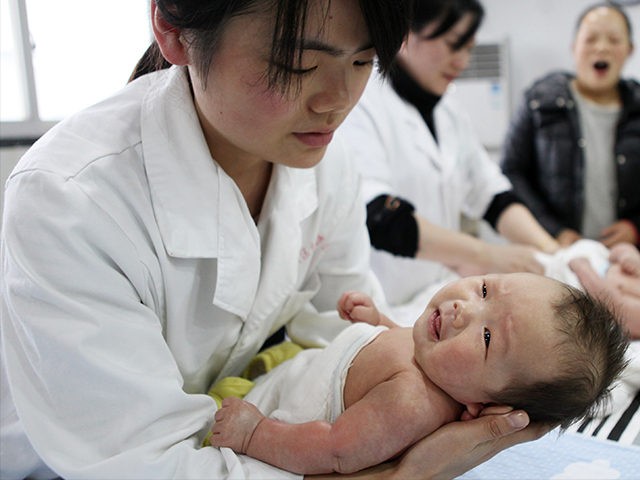A scientist studying population development in China revealed on Tuesday that the Communist Party “seriously overestimated” how many babies were born in 2019, a year whose official birthrate was the lowest in the history of the People’s Republic.
Yi Fuxian, a scientist and researcher at the University of Wisconsin-Madison, wrote in the South China Morning Post this week that the number of births and total population of China published by the National Bureau of Statistics differs significantly from tallies published by other Beijing agencies such as the census offices and the health ministry. Past birthrate estimates, he noted, also appeared tampered with when taking into account the current number of children registered at Chinese schools that correspond to those years.
The National Bureau of Statistics published data showing that 14.65 million babies were born in 2019, a number Yi contended is off by millions:
My estimates show that China’s actual population size should be 1.279 billion at the end of 2019, or 121 million fewer than the officially stated 1.4 billion. The actual number of births in China last year should be about 10 million instead of 14.65 million, as reported by the National Bureau of Statistics.
Yi used several different metrics to evaluate the official number, such as the health authorities annual yearbook of babies born in hospitals, which showed a significantly smaller number even accounting for the estimated 0.1 percent of births not taking place there. He also noted that, in past years, alleged increases in birthrates did not correpond to increased sales of baby products or, in the longer-term, the same number of children matriculated in schools:
For instance, the statistics bureau said China had 15.23 million births in 2018, but the Health Statistics Yearbook compiled by China’s health care authority, which cover new births in all hospitals, showed that there were only 13.62 million. The hospital delivery rate is 99.9 per cent in China, which may account for some of the discrepancy of 1.61 million births. But this still doesn’t account for the bulk of the 1.61 million “births.”
[…]
The 2000 census showed that only 14.08 million were born in 2000, but the statistics bureau revised it to 17.71 million. However, there were only 14.26 million secondary students in 2014.
Yi blamed not only government attempts to hide the real data for the discrepancies in numbers, but widespread corruption at the local level. Parents reportedly purchase birth certificates from hospitals for babies that do not exist to receive more public benefits; local governments do not mind the purchases if a perceived growth in population also means Beijing will send them more funding.
“The difference is because, firstly, the number of births is often inflated so that individuals and hospitals can claim more medical subsidies,” Yi wrote. “Secondly, as more than 20 social benefits are tied to one’s place of birth, under the hukou household registration system, some parents buy additional birth certificates to provide a ‘dual citizenship’ to their newborn.”
Yi concludes that 2019’s birthrate in China was not just the lowest in the history of the 70-year-old communist state, but the lowest since 1790.
China imposed a brutal campaign of forced sterilization and abortion on its citizens for decades known as the “one-child policy,” which communist officials believed necessary to prevent mass starvation due to lack of food and other resources. The Party identified a declining birthrate as a problem years ago, however, and expanded the “one-child policy” to a “two-child policy” in 2016. Communist Party officials predicted at the time that the number of infants would skyrocket and that 2017 would yield 20 million births.
The country has experienced a consistent decline in birthrate since then, despite the legality of having more children. China marked the first population decline in the history of the founding of the communist state in 2018. While a lack of desire among young people to have children out of career concerns has surfaced as a potential cause, the devastating effects of the one-child policy on female birth rates is largely to blame. Traditional Chinese culture tends to prize sons more than daughters, leading many to abort female fetuses knowing they can only keep one child. Infanticide after a girl was born also grew increasingly common decades ago, now resulting in a shortage of women of child-bearing age.
The Global Times, a state propaganda outlet, insisted following the publication of the 2020 statistics that there is “no population crisis so far.” In past years, the state has attempted to implement policies to get couples together and, hopefully, produce more children. Last year, two Chinese tourism companies expanded their Lunar New Year vacations, but only for single women, calling the break “dating leave” to be used to find a husband. In 2017, the Communist Youth League launched an official dating service, promising to find users a partner truly loyal to the cause.
Follow Frances Martel on Facebook and Twitter.

COMMENTS
Please let us know if you're having issues with commenting.